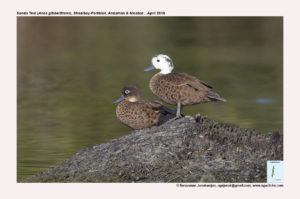Sunda Teal

Sunda Teal Anas gibberifrons
Etymology:
- Anas : Latin word for Duck
- Gibberifrons: Latun word gibber- hump; frons-forehead.
Distribution in India: Resident of Andaman Island in India.
Description: Size of 37–47 cm; male wt. is300–450 g, female wt. is 360–455 g; wingspan of 60–67 cm. It has an uniform grey with indistinct scaling or mottling formed by pale fringes to feathers, head is faintly streaked, noticeably darker on crown and paler over face, chin and upper throat are spotted creamy white, breast is obviously spotted, wings are dark brown with prominent white wedge along leading edge of black speculum and narrow white tips to trailing edge, oval patch of bronze-green on inner speculum, brown underwing with black-brown leading edge, white axillaries and central coverts. The bill is blue-grey, darker on culmen ridge, legs and feet are dull grey, and eyes bright crimson. It has protuberance on forehead variable, but usually larger in male. The male lacks eclipse plumage. The female is slightly smaller with duller iris. The juvenile is paler than female, especially on head and neck, and eyes dull brown.
Habitat: It is found in all types of wetlands, with shallow, fresh, brackish or saline waters; often on temporarily flooded areas, and coastal lagoons. Also found on rivers, with large concentrations sometimes recorded in mangrove swamps and has been observed on sea.
Food habits: When on land it eats seeds and vegetative parts of aquatic and shoreline vegetation, grasses and sedges; small aquatic invertebrates, insects and their larvae, molluscs, crustaceans,. It feeds by dabbling, mud filtering in shallow water and by picking up insects and seeds, at least occasionally dives for food. Upending and dipping were the commonest foraging method.
Breeding habits: They breed Jan-Feb in Andaman Islands India .In single pairs or loose groups. The nest is made of plant matter available at site, lined with copious grey down, in slight depression on ground among vegetation, sometimes in natural cavities in tree. They lay a clutch of 7–8 eggs. The incubation period is 26–30 days. The incubation is done by female alone. The fledging period is 7–8 weeks, and broods sometimes remain with both adults for several additional weeks.